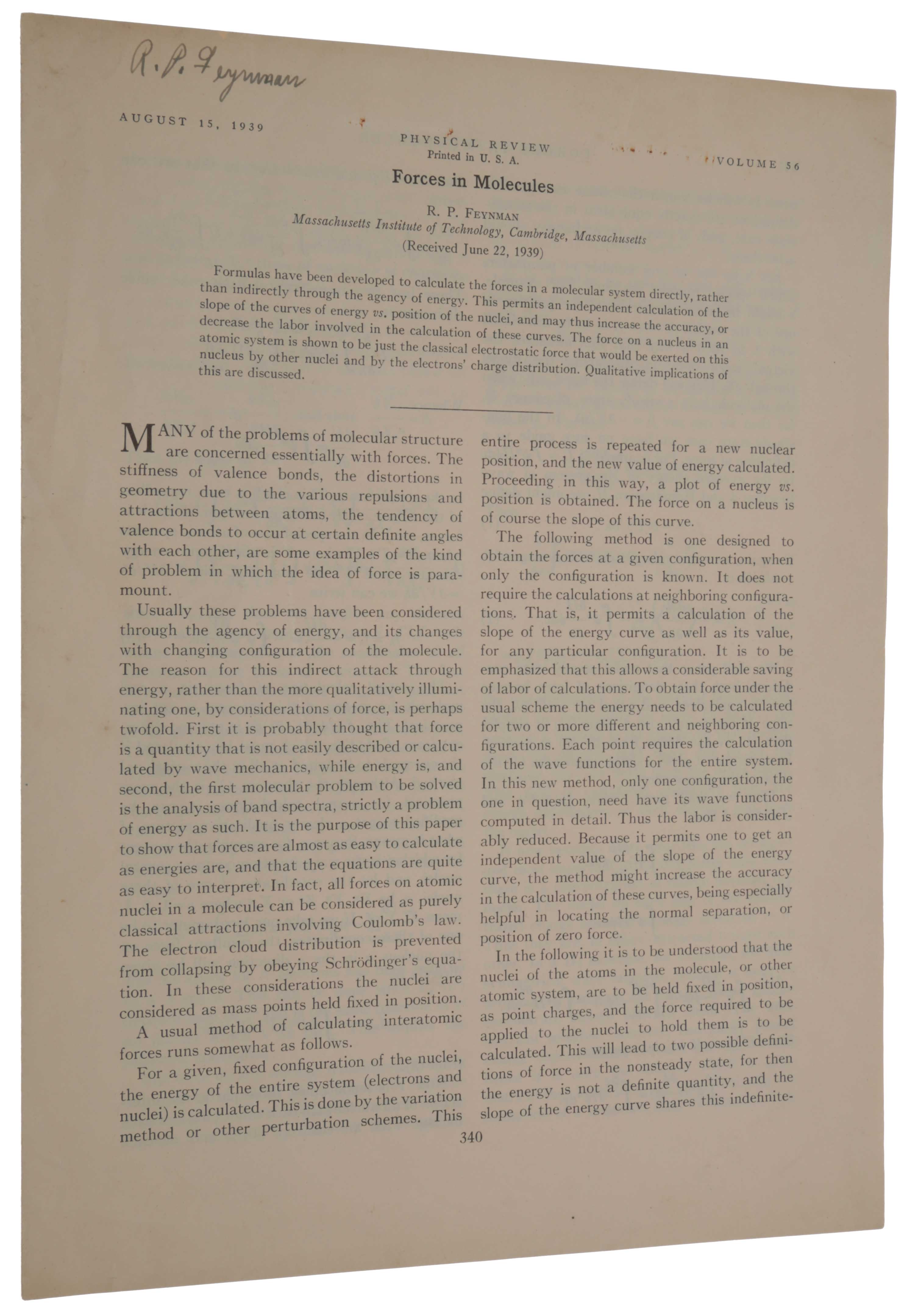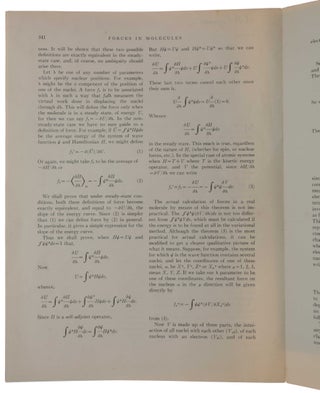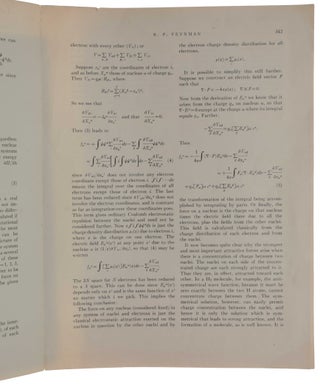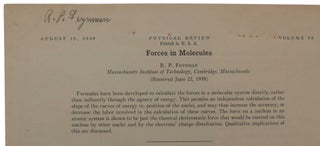Forces in molecules. Offprint from: Physical Review, Second Series, Vol. 56, No. 4, August 15, 1939.
[Lancaster, PA & New York, NY: American Institute of Physics for the American Physical Society, 1939]. First edition, extremely rare offprint, inscribed by Feynman, of Feynman’s senior undergraduate thesis at MIT, a fundamental discovery “that has played an important role in theoretical chemistry and condensed matter physics” (Selected Papers, p. 1), published when he was just twenty-one. This is a remarkable paper, documenting the first steps in original research of one of the most brilliant minds of the twentieth century. “Feynman was one of the most creative and influential physicists of the twentieth century. A veteran of the Manhattan Project of World War II and a 1965 Nobel laureate in physics, he made lasting contributions across many domains, from electrodynamics and quantum theory to nuclear and particle physics, solid-state physics, and gravitation” (DSB). Feynman showed that “the force on an atom’s nucleus is no more or less than the electrical force from the surrounding field of charged electrons – the electrostatic force. Once the distribution of charge has been calculated quantum mechanically, then from that point forward quantum mechanics disappears from the picture. The problem becomes classical; the nuclei can be treated as static points of mass and charge. Feynman’s approach applies to all chemical bonds. If two nuclei act as though strongly attracted to each other, as the hydrogen nuclei do when they bond to form a water molecule, it is because the nuclei are each drawn toward the electrical charge concentrated quantum mechanically between them” (Gleick, Genius: The Life and Science of Richard Feynman). His discovery, now known as Feynman’s theorem or the Feynman-Hellmann theorem, has endured as an efficient approach to the calculation of forces in molecules. “The importance of the forces on the atomic nuclei for molecular geometry, the theory of chemical binding, and for crystal structure is evident” (Selected Papers, p. 1). ABPC/RBH lists no copy of any offprint of any of Feynman’s papers in Physical Review (where he published almost all of his most important work). Not on OCLC. Provenance: Signed ‘R. P. Feynman’ in pencil in top margin of first page. This offprint was signed by Feynman and given by him to Robert Kinsel Smith (1920-99), a classmate and personal friend of Feynman’s at Princeton University, where both Feynman and Kinsel Smith studied for their PhDs (a letter from Kinsel Smith’s son testifying to this provenance accompanies the offprint). Born in Far Rockaway in the Queens section of New York City, Feynman (1918-88) entered the Massachusetts Institute of Technology (MIT) in 1935 to begin his undergraduate studies. Although he originally majored in mathematics, he later switched to electrical engineering, as he considered mathematics to be too abstract. Noticing that he ‘had gone too far,’ he then switched to physics, which he claimed was ‘somewhere in between.’ To complete their bachelor’s degree, all physics majors at MIT were then (as now) required to write a ‘senior thesis’. “Thirteen physics majors completed senior theses in 1939. The world of accumulated knowledge was still small enough that MIT could expect a thesis to represent original and possibly publishable work. The thesis should begin the scientist’s normal career and meanwhile supply missing blocks in the wall of organized knowledge, by analyzing such minutiae as the spectra of singly ionized gadolinium or hydrated manganese chloride crystals … Seniors could devise new laboratory instruments or investigate crystals that produced electrical currents when squeezed. Feynman’s thesis began as a circumscribed problem like these. It ended as a fundamental discovery about the forces acting within the molecules of any substance” (Gleick). Feynman recounted his work on the thesis in an interview with Charles Weiner in March, 1966. “I went to Slater [the renowned solid-state theorist John Clarke Slater (1900-76)], and he gave me a problem, which was … why does quartz have such a small coefficient of expansion? He thought that maybe the possibility was that the quartz crystal has moveable — see it’s silicone dioxide, SiO2 so I think there are oxygen’s clinging to silicones, and in the motion the oxygen can swing back and forth, and it’s a bent angle, turning back and forth, like the bores on the governor of an old steam engine, and when it turns — when this is oscillating, it’s the same idea — it pulls the heads of the steam engine together, the ends, because the bore goes out by centrifugal force. And so the bent bottom will be shortened — I mean, it will be pulled together by the motion — and this will compensate the ordinary effects which tend to make something expand, so that the expansion will be much less than usual. Can I work out any details or estimates or something to show that in fact that’s the reason that quartz doesn’t expand? All right, that was the problem. I was very interested in it. The first thing I did was, I looked up the forms, crystobalite A, crystobalite B, crystal forms, and so on, to get the idea of the bonds and the angles and so on. I got in the crystal business. Then I realized I’d have to figure out how a change in forces will change the dimensions of the crystal. So then I got involved … with the connection between the forces between the atoms, and the forces — all together. For example, if a crystal is compressed, what is the compressent strength? Supposing I assume certain spring constants between all the atoms and I want to know what the elastic constants of the whole crystal are. I realized that what I had to do there was an infinite bridge truss problem, like the guys in applied engineering with bridges with a lot of members. I had an infinite number of members. But, because of the periodicity, I had an advantage that I could work out. Then I gradually developed the theory of the connection between the elastic bonds … So I worked that out, and then discovered by fooling around that I could get it for a principle of energy minimum … But anyway, in the meantime I’d found this theorem about the forces, but the force on the nucleus is nothing but the electrostatic attraction of all the electrons, the distribution of the electrons being determined by the Schrödinger equation. Slater found this interesting and unusual, and hadn’t known that. He challenged me, and said, ‘How do you explain van der Waals forces that way?’ So I went back and I proved that the van der Waals force could also be understood that way. Then he said it was worthwhile, I ought to publish it. So I wrote it up. And he said, ‘Let Conyers Herring look at it’ [Conyers Herring was then a postdoctoral fellow under Slater]. He was good at these things. Herring looked at it, and there was a long session. He said, ‘Take this out.’ I had the proof that the integral of F times HG, where H is the Hamiltonian, was the same as HF star times G, integrated. And I proved it with the Schrödinger equation … Herring says to me, ‘Take that out, and write instead such and such equals such and such because H is Hermitian self-adjoining [i.e., self-adjoint].’ I said, ‘What does that mean?’ He said, ‘That’s what it means. It means that equation is true.’ I’m just saying this to show the level of what I knew. See, I proved everything by hand — I didn’t go into the general. So he took that out, and so on, and then I proved this theorem, and it was in this paper” (AIP Oral History Interviews, Richard Feynman – Session II, https://www.aip.org/history-programs/niels-bohr-library/oral-histories/5020-2). Mehra gives the following account of he theorem Feynman is referring to. “The primary motivation for the thesis appears to stem from the following intuitively appealing theorem, which Feynman enunciated and proved: ‘The force on any nucleus (considered fixed) in any system of nuclei and electrons is just the classical electrostatic attraction exerted on the nucleus in question by other nuclei and by the electron charge distribution’ (*) … “Feynman’s theorem (*) opened up a new and more revealing picture of the physical mechanism of the van der Waals force. The same may be said of the physical mechanism of the covalent or homopolar chemical bond, in which connection Feynman’s theorem is held in considerable esteem among the physical chemists. In order to understand why this should be so, it is only necessary to observe that the older textbooks treating the bond tended to display the bonding effect as a somewhat mysterious quantum mechanical concomitant of the exchange antisymmetry of the overall wave function and the pairing of electron spins, whereas Feynman focused attention solely on the charge distribution engendered by the spatial factor of the wave function and the chemically desirable Coulomb forces exerted by this charge distribution. “Feynman’s theorem (*) is often referred to in the literature as the ‘Hellman-Feynman theorem.’ This terminology may be inexact, in so far as Hellman [a German physical chemist] did not envisage the Feynman force theorem (*)” (Mehra, The Beat of a Different Drum, pp. 72-78). The thesis carried the title ‘Forces and stresses in molecules.’ “Slater made him rewrite the first version. He complained that Feynman wrote the way he talked, hardly an acceptable style for a scientific paper. Then he advised him to submit a shortened version for publication. The Physical Review accepted it, with the title shortened as well, to ‘Forces in Molecules’” (Gleick). “Many years later, in summer 1949, Feynman went to give lectures on quantum electrodynamics at the University of Michigan summer school at Ann Arbor. There, ‘Ted Berlin, who was in physical chemistry, said, ‘Have you heard all the debates about your Feynman-Hellman theorem?’ I said, ‘What theorem?’ He said, ‘It’s called the Feynman-Hellman theorem, the force law between molecules.’ Everyone was arguing it across the ocean. The Americans were saying I was right and the Germans were saying that I had made two mistakes: I left out the kinetic energy and something else. But anyway, they thought that things cancelled out and I was just lucky. But my proof was really sound, and it wasn’t just a matter of luck. There was no mistake’” (Mehra, p. 78). In the published paper ‘Forces in Molecules,’ Feynman cited no references, but he expressed gratitude to Slater and Conyers Herring. The paper has been cited almost 2000 times.
Large 8vo (267 x 200 mm), pp. 340-343. Self-wrappers as issued, fine. Custom calf box with gilt spine lettering.
Item #4833
Price: $42,500.00





